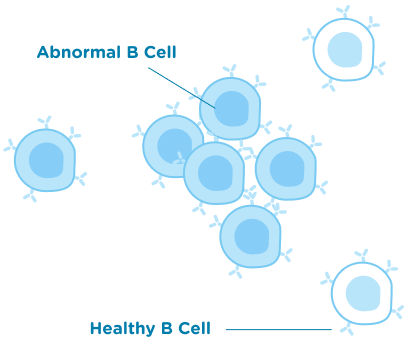Genetic testing can give your doctor important information about how your condition may progress over time, which can help inform treatment decisions.3
Understanding Chronic Lymphocytic Leukemia/Small Lymphocytic Lymphoma (CLL/SLL)1,2
Receiving a diagnosis of CLL/SLL may seem overwhelming at first, but understanding your condition can help you feel more at ease. It’s important to recognize that you are not alone. Here are some fast facts:
- CLL accounts for about one quarter of all new cases of leukemia in the United States
- The estimated number of new CLL cases for 2024 is 20,700
- The median age at CLL diagnosis is 69 years old
- CLL is more common among men
CLL/SLL is a slow-growing blood cancer. The cancer occurs in B cells, a type of white blood cell. B cells are an important part of your immune system, which defends your body against infection. In CLL/SLL, abnormal B cells grow and spread in the bloodstream. They can also crowd out healthy cells in several parts of the body.

Have you been prescribed IMBRUVICA® (ibrutinib)?
From cost and coverage options to By Your Side Registered Nurse support—we're here to help.*

Lymph Nodes
These glands contain immune cells that fight infections, found in the base of your neck, groin, armpits, and other parts of the body.4
Bone Marrow
This is the soft inner part of bones where most blood cells are made.5
Spleen
This organ stores and filters
blood cells.5
CLL cells are most often found in the blood and bone marrow, but can also be found in the lymph nodes and spleen.3
The main difference is where the cancer cells are found. In CLL, most cancer cells are in the blood and bone marrow. They can also be found in the lymph nodes and spleen. In SLL, the cancer cells are mainly in the lymph nodes.3
Understanding how CLL/SLL affects your blood
CLL cells (abnormal B cells) build up slowly over time. This leads to changes in your blood, including changes in the number of these blood cells.3
Lower red blood cell counts (anemia)
Can cause tiredness.
Lower platelet counts (thrombocytopenia)
Can cause an increased tendency to bleed.
Lower counts of certain white blood cells (neutropenia)
Can make it easier to get infections.
What are the common signs and symptoms of CLL/SLL?3
For many patients, a diagnosis can come as a shock because they may not feel sick. You may not experience symptoms for years, but over time, signs and symptoms of CLL/SLL will appear. It's important to keep your doctor updated when new symptoms appear or existing symptoms worsen. Symptom changes can mean your CLL/SLL is getting worse.
As the disease progresses, you may experience one or more of the following common symptoms.
Other signs and symptoms3,6:
Chills
Fever
Night sweats
Tiredness
Unexpected weight loss
No two patients are alike, so be sure to tell your doctor how you are feeling and if you are experiencing any new symptoms. If you are feeling mentally or physically tired, for example, it’s important to let your healthcare team know.
Tracking your test results and symptoms gives you a picture of how you’re doing over time. When you track your symptoms, you can share them with your doctor to spot any patterns. Your doctor can also help you understand how your condition changes over time. You can then work with your doctor to address anything that needs attention.
Remember, since tracking helps you notice changes and patterns over time, it’s a good idea to track regularly.
You can track any way you want. Make a list on your phone or keep a journal. You can even keep a video diary—it’s all about what’s convenient and easy for you.

Get useful tips and questions to ask your doctor that may help you make the right treatment decisions together.
IMBRUVICA® By Your Side patient support program is not intended to provide medical advice, replace prescribed treatment plans, or provide treatment or case management services. Patients are advised to talk to their healthcare provider and treatment team about any medical decisions and concerns they may have. By Your Side Registered Nurses are provided by Janssen Biotech, Inc. and Pharmacyclics LLC, an AbbVie Company, and do not work under the direction of your healthcare professional (HCP) or give medical advice. They are trained to direct patients to their HCP for treatment-related advice, including further referrals.
References: 1. American Cancer Society. Key Statistics for Chronic Lymphocytic Leukemia. Revised January 17, 2024. Accessed January 15, 2025. https://www.cancer.org/cancer/types/chronic-lymphocytic-leukemia/about/key-statistics.html 2. SEER Cancer Stat Facts: Chronic Lymphocytic Leukemia (CLL). National Cancer Institute. Accessed January 15, 2025. https://seer.cancer.gov/statfacts/html/cllsll.html 3. Leukemia and Lymphoma Society. Chronic Lymphocytic Leukemia. Published June 2021. Accessed January 15, 2025. https://www.lls.org/sites/default/files/2021-07/PS34_CLL_Booklet_2021.pdf 4. American Cancer Society. Lymph Nodes and Cancer. Revised March 2, 2021. Accessed January 15, 2025. https://www.cancer.org/cancer/cancer-basics/lymph-nodes-and-cancer.html 5. National Cancer Institute. NCI dictionary of cancer terms. Accessed January 15, 2025. https://www.cancer.gov/publications/dictionaries/cancer-terms 6. IMBRUVICA® (ibrutinib) Prescribing Information. 7. Vernooij RWM, Willson M, Gagliardi AR. Characterizing patient-oriented tools that could be packaged with guidelines to promote self-management and guideline adoption: a meta-review. Implement Sci. 2016;11(52):1-13. doi:10.1186/s13012-016-0419-1 8. National Institutes of Health. A Guide for Older People: Talking With Your Doctor. National Institute on Aging. Published December 2016. Accessed January 15, 2025. https://order.nia.nih.gov/sites/default/files/2017-07/TWYD_508.pdf


